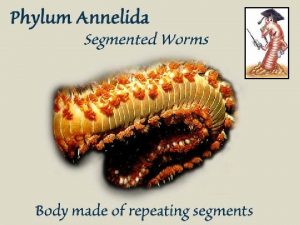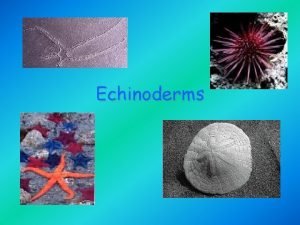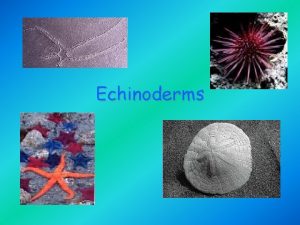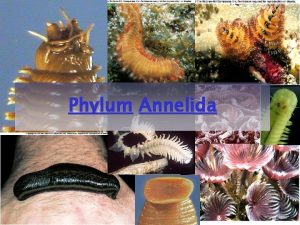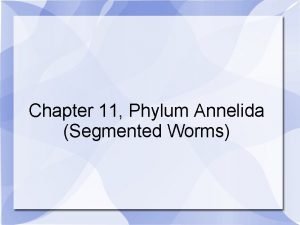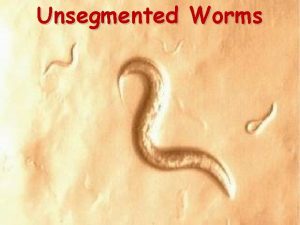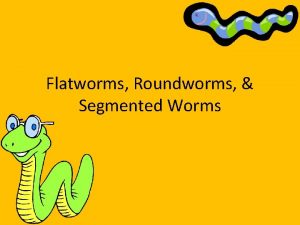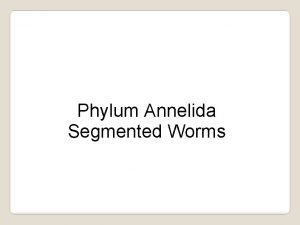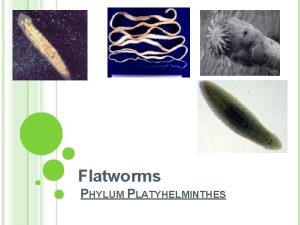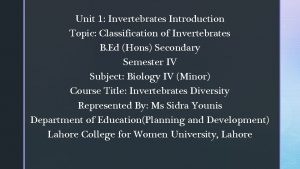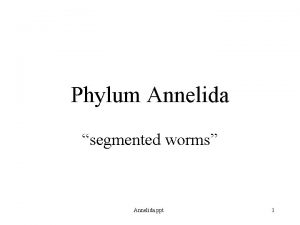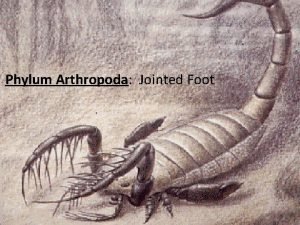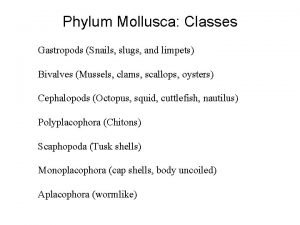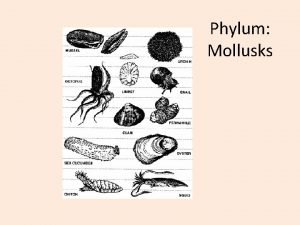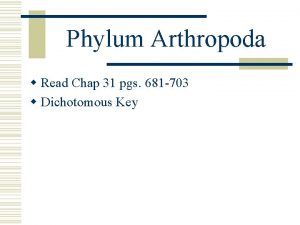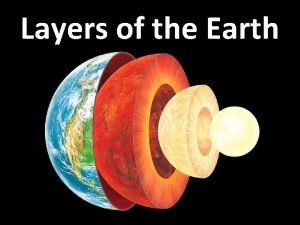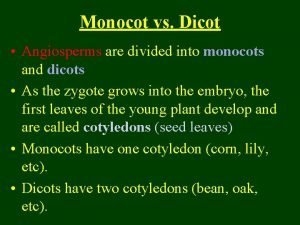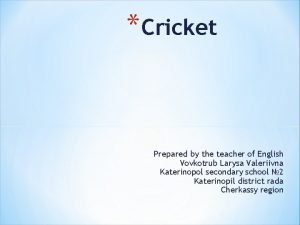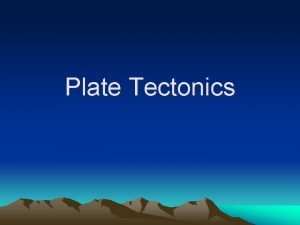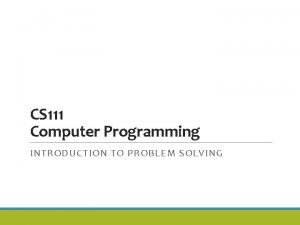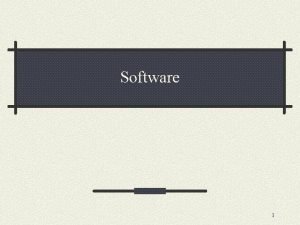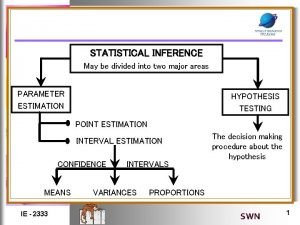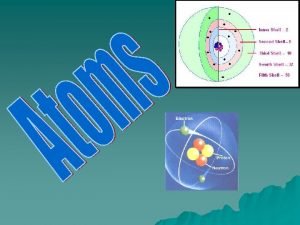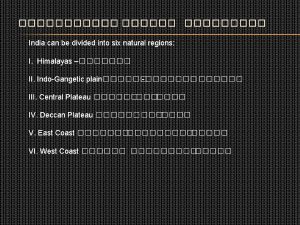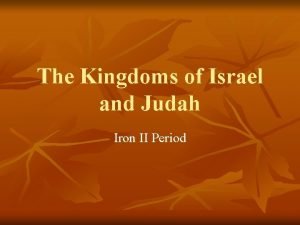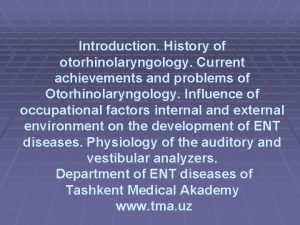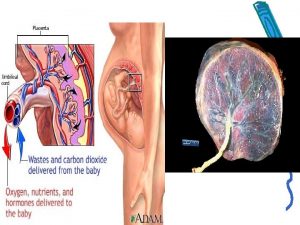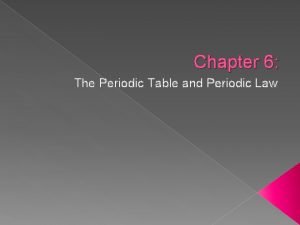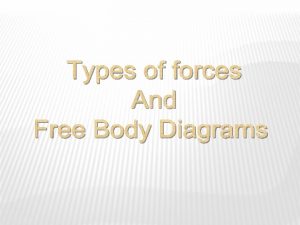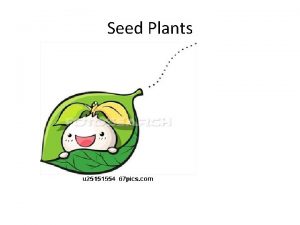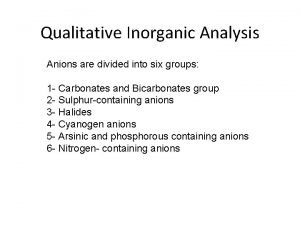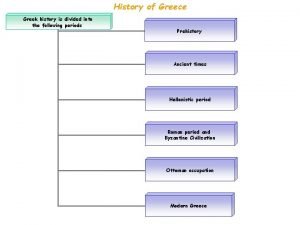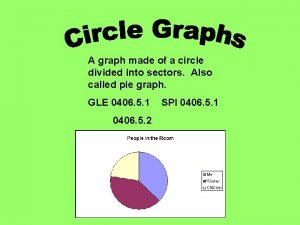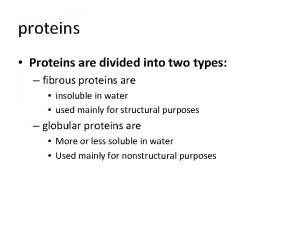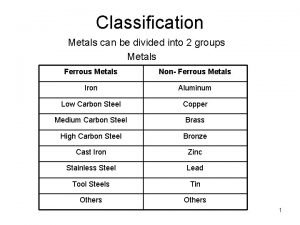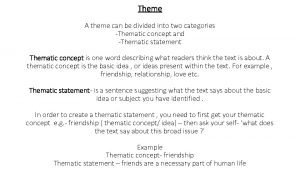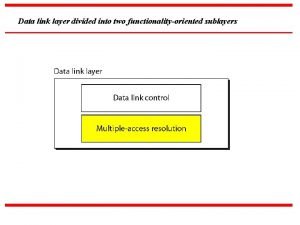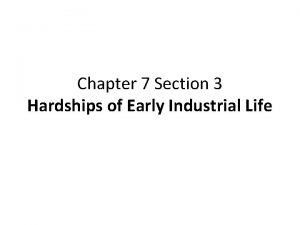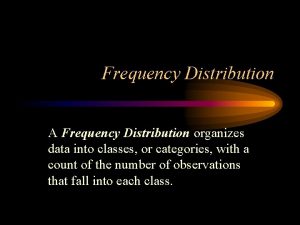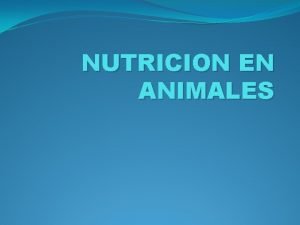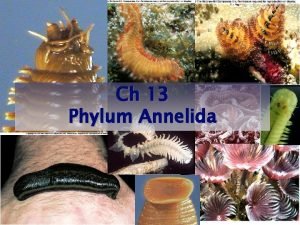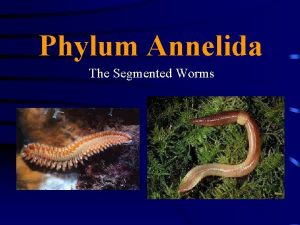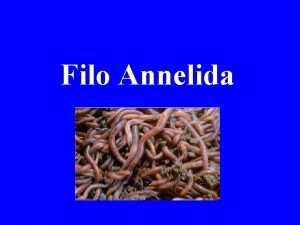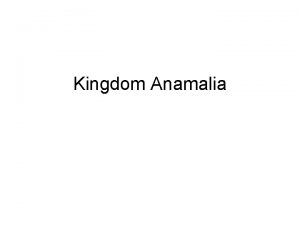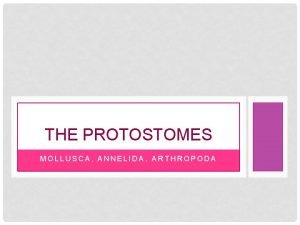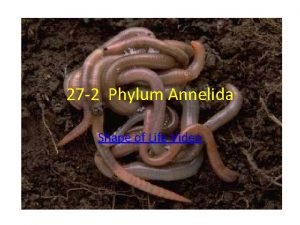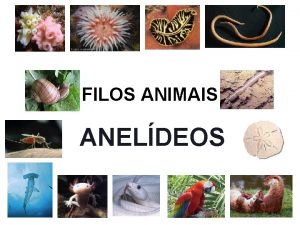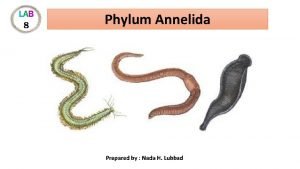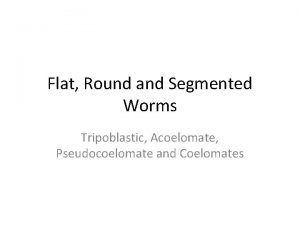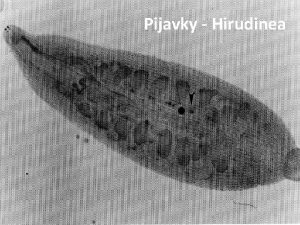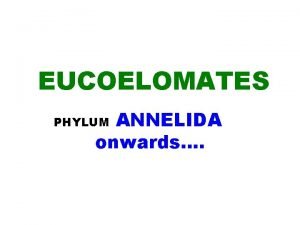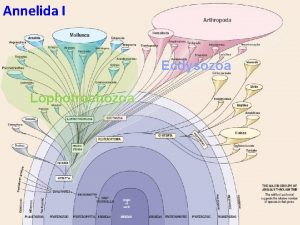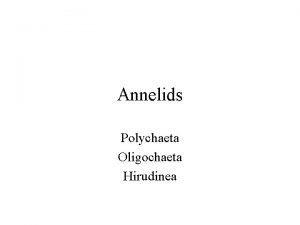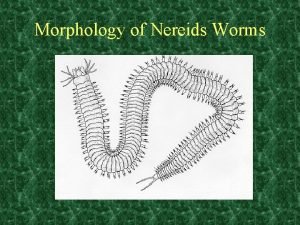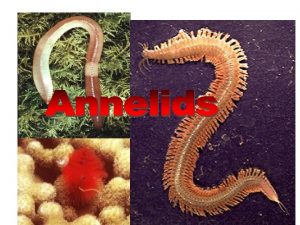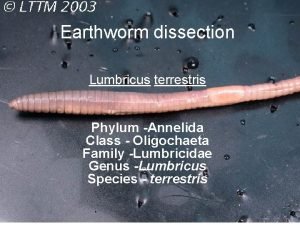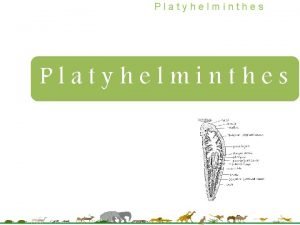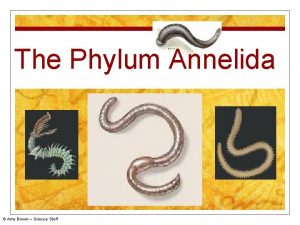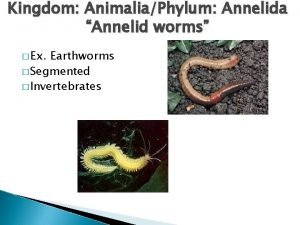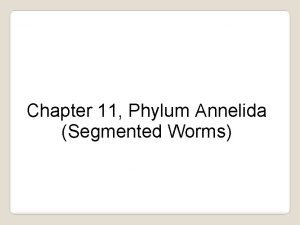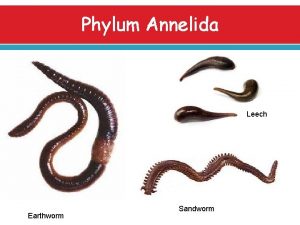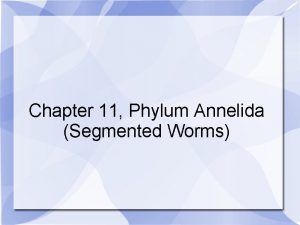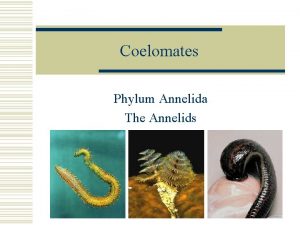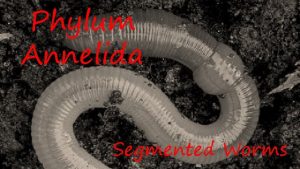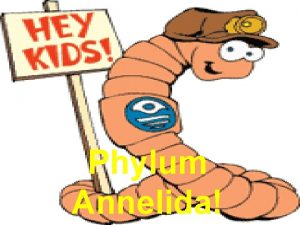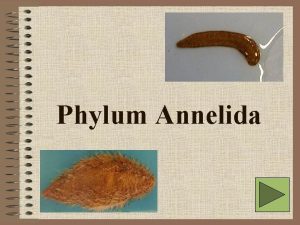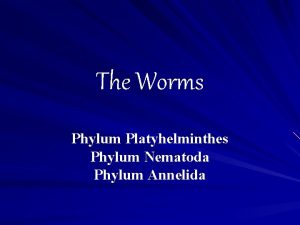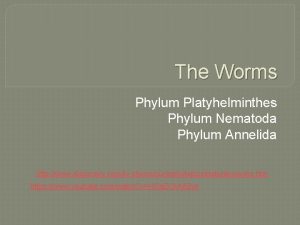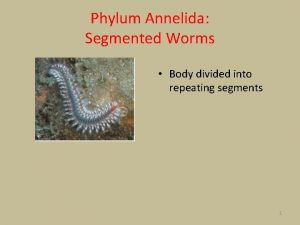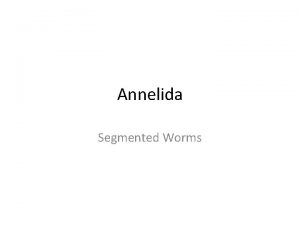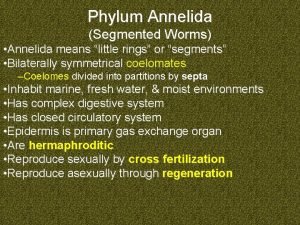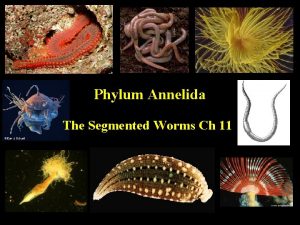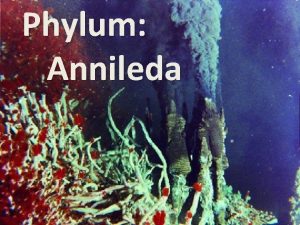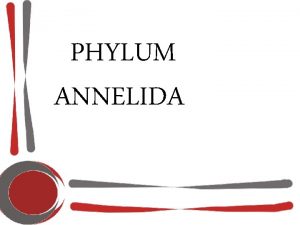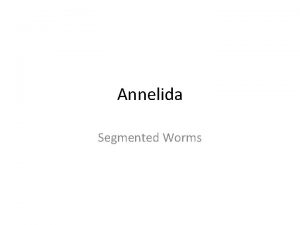The phylum Annelida is divided into 3 classes

















































































































- Slides: 113




The phylum Annelida is divided into 3 classes

WHAT IS NEW? ØHave repeating segments separated by a ‘septum’. ØEach of the segments are very similar. ØThe segments allow controlled movement. ØEach segment is a compartment with its own separate nerve center, that are connected with coordinating nerve cords.

ØThey have a true coelom located between two layers of mesoderm.

ØFirst CIRCULATORY SYSTEM ØTransports oxygen and food to the cells. ØFrees annelids from diffusion, which is slow and inefficient. ØSo… you can get bigger.

ØFirst CIRCULATORY SYSTEM ØThe annelids have a closed circulatory system ØSo there is blood in the blood vessels all of the time ØThey have FIVE hearts that pump the blood.

ØNERVOUS SYSTEM: ØReduced to one main VENTRAL NERVE ØThis gives them better discrimination. ØCEPHALIZATION: they have a dorsal, anterior ‘BRAIN’, which is just a ganglia or group of nerve masses. ØThe sense organs are also improved and this allows for more complex behaviours.


ØEXCRETORY SYSTEM: Ømore specialized ØLocated in each segment ØKidney like structures called NEPHRIDIA




ØREPRODUCTION: ØMainly sexual ØThese worms are HERMAPHRODITIC. ØThey have also developed the ability to regenerate (asexual reproduction).


ØRESPIRATORY SYSTEM: ØNot truly evolved yet ØAnnelids respire/gas exchange through skin, gills or parapodia ØThey have a MOIST CUTICLE (to allow for better exchange of gases across the skin)

ØAnnelids were the FIRST LAND DEVELOPED ANIMALS

ALSO… Still has… A)Bilateral symmetry B) Complete Digestive System C) Muscular Body Wall Different… • Chitinous SETAE • Hard bristles made of chitin • appendages (not in leeches)


IMPORTANCE • Earthworms, of the phylum Annelida are food for birds, and keep the soil aerated. • Sometimes large earthworms are used for dissection in first-term Biology classes, to teach the understanding of basic internal organs. • Leeches are also annelids, and help with healing wounds.

http: //www. youtube. com/watch? v=Ld. Hz. RNdz 2 HU&feature=fvw 10, 000 Species


Polychaetes • Members of class Polychaeta – Called “SANDWORMS” or “MARINE WORMS” – Possess paddle-like parapodia that function as gills and aid in locomotion – Many live in tubes Parapodia




1. Paired eyes and tentacles at the anterior end.




2. Parapodia with setae (stiff bristles)

3. Release gametes into the water for fertilization by the opposite sex.

4. Trochophore larva (they are proterostomes). Some are motile while others live in tubes that they secrete.

LARVAE

5. Mouth parts = PROTOSTOMIUM



The Polychaetes: tube and feather duster worms http: //www. youtube. com/w atch? v=Z_Aqcs. YZ 0 G 8&N R=1

Mode of Energy: Tube dwellers ~ Feed by trapping food in mucus Mobile~ Predators or herbivores Prey on small invertebrates Are prey for fish and larger invertebrates Tube dwelling Polychaeta rework the soil in ocean






FIRE WORM Description: segmented worm with long white bristles up to 5 cm length. Habitat: under rocks and in coral rubble in shallow water. WARNING: this species has venomous setae


http: //www. youtube. com/watch? v= D 1 Pj. Jb. R 9 zos&feature=related



SPAGHETTI WORM http: //www. youtu be. com/watch? v= DPc. MKy. Md. SSI Description: long, white tentacles (up to 1 m) radiating out from a central burrow

http: //www. youtube. com/watch? v=u. Fa. Yob. ENo. GA The world’s most heat tolerant creature; lives in underwater steam vents. Very hot. Has symbiotic relationship with bacteria that live on its back. The bacteria have enzymes that help it survive. DEEP SEA POMPEII WORM




http: //www. youtube. com/watch? v=Gm. Ze 0 trz. PLQ


FEATHER DUSTER http: //www. youtube. com/watch? v= _VNep 2 mh 7 y. U&NR=1



MORE FEATHER DUSTERS



CHRISTMAS TREE WORMS http: //www. y outube. com/ watch? v=UW 3 v. DVrs 4 OQ

Coco worm emerges: http: //www. youtube. com/watch? v= ZBVrgvko. Nn. A&NR=1









ICE CREAM CONE WORM

500 Species

Mountain leech vs. giant earthworm: http: //www. youtube. com/watch? v=v pv 9 P 1 KOVMQ&feature=fvw The Leeches: the blood suckers

Leeches • Members of class Hirudinea – Are blood-sucking parasites, such as leeches “once they settled themselves onto your skin, you had to wait until they drank their fill and fell off of their own accord, because if you sought to pull t hem loose, you would merely tear the leech in half, leaving its teeth embedded in your flesh”.

Leeches Ølive on land or in freshwater ØAre almost entirely external parasites ØSegments are not compartmentalized like other annelids ØSegments are modified to form suckers at anterior end ØAttaches to substrate with posterior end ØIts mouth has three toothed jaws used to make incision in host, and secretes an anticoagulant to keep blood from clotting






Mode of Nutrition: Carnivorous predators or parasitic ~ use sucker to grasp prey or attach to host Manners of Feeding: Parasitic leeches can eat a hole through the skin of their host or slit the skin of the host. Leeches will draw out as much blood as possible from the host and can then survive for several months without feeding again.










• Feed on small invertebrates • Previously used by physicians for blood letting • Currently used by physicians during the reattachment of human limbs • Control swelling and allow veins to grow and reconnect • Currently research is being conducted for using leech neurons as an intricate part in the newest computer microprocessors





The Earthworm: the dirt grinders http: //www. youtube. com/watch? v=DZig 6 EL 5 B 6 A Giant earthworm: http: //www. youtube. com/watch? v=Nhs. H 2 ok. FNGU&feature=related

Oligochaetes • Class Oligochaeta – Are named for their relatively few chaetae (bristles made of chitin) – Include the earthworms and a variety of aquatic species



Giant New Zealand Earthworm

Giant Blue Earthworm

• Earthworms eat their way through the soil, extracting nutrients as the soil moves through their digestive tract – Which helps till the earth, making earthworms valuable to farmers

On average, earthworms eat 1/3 in their body weight every day

Anatomy of an earthworm Coelom. The coelom of the earthworm is partitioned by septa. Each segment is surrounded by longitudinal muscle, which in turn is surrounded by circular muscle. Earthworms coordinate the contraction of these two sets of muscles to move (see Figure 49. 25). These muscles work against the noncompressible coelomic fluid, which acts as a hydrostatic skeleton. Epidermis Septum (partition between segments) Circular muscle Many of the internal structures are repeated within each segment of the earthworm. Chaetae. Each segment has four pairs of chaetae, bristles that provide traction for burrowing. Longitudinal muscle Dorsal vessel Anus Intestine Nerve cords Cerebral ganglia. The earthworm nervous system features a brain-like pair of cerebral ganglia above and in front of the pharynx. A ring of nerves around the pharynx connects to a subpharyngeal ganglion, from which a fused pair of nerve cords runs posteriorly. Cuticle Metanephridium. Each segment of the worm contains a pair of excretory tubes, called metanephridia, with ciliated funnels, called nephrostomes. The metanephridia remove wastes from the blood and coelomic fluid through exterior pores. Nephrostome Pharynx Tiny blood vessels are abundant in the earthworm’s skin, which functions as its respiratory organ. The blood contains oxygen-carrying hemoglobin. Ventral vessel Clitellum Esophagus Metanephridium Crop Giant Australian earthworm Intestine Gizzard Mouth Subpharyngeal ganglion The circulatory system, a network of vessels, is closed. The dorsal and ventral vessels are linked by segmental pairs of vessels. The dorsal vessel and five pairs of vessels that circle the esophagus of an earthworm are muscular and pump blood through the circulatory system. Ventral nerve cords with segmental ganglia. The nerve cords penetrate the septa and run the length of the animal, as do the digestive tract and longitudinal blood vessels.

Earthworms live on land. ØNo parapodia, eyes or tentacles. ØFew setae (they feel rough to the touch) ØExclusively hermaphroditic: eggs are laid in a cocoon outside of the adults body after fertilization. ØMost commonly known example is an earthworm.


Lumbricus terrestris

3, 000 Species Mode of Nutrition: Feed primarily on detritus and algae Earthworms cycle through huge quantities of soil.

• Undigested materials and mucous rework the soil and sediment for farmers • Aeration of soil is beneficial to farmers, plant roots and other organisms living in the soil

A flatworm attacking an earthworm
 Protostomium
Protostomium Nutrients are divided into how many classes
Nutrients are divided into how many classes Echinodermata means
Echinodermata means Spiny skin
Spiny skin Annelid classes
Annelid classes Segmented worms phylum
Segmented worms phylum Polychaeta labeled
Polychaeta labeled Filum annelida
Filum annelida Pinworms and hookworms belong to the phylum
Pinworms and hookworms belong to the phylum Segmented roundworms
Segmented roundworms Worm digestive system
Worm digestive system Phylum platyhelminthes general characteristics
Phylum platyhelminthes general characteristics Drieved
Drieved Annelida ppt
Annelida ppt Classe e subclasse de palavras 7. ano
Classe e subclasse de palavras 7. ano Pre ap classes vs regular classes
Pre ap classes vs regular classes Classes in phylum arthropoda
Classes in phylum arthropoda Limpets phylum
Limpets phylum Three classes of mollusks
Three classes of mollusks Classes in phylum arthropoda
Classes in phylum arthropoda Arthropod
Arthropod Israel divided into two kingdoms
Israel divided into two kingdoms Which layer of earth is divided into plates
Which layer of earth is divided into plates Buttercup monocot or dicot
Buttercup monocot or dicot Can be divided into
Can be divided into A cricket match is divided into periods called
A cricket match is divided into periods called William wordsworth is known as a
William wordsworth is known as a Two plates spread or move apart at what boundary
Two plates spread or move apart at what boundary A typical programming tasks can be divided into two phases
A typical programming tasks can be divided into two phases Number one
Number one Statistical inference is divided into
Statistical inference is divided into Divine comedy is divided into 3 parts. what are those
Divine comedy is divided into 3 parts. what are those Pie chart is divided into
Pie chart is divided into Smallest particle of element
Smallest particle of element India is divided into how many natural regions
India is divided into how many natural regions Kingdoms of israel and judah
Kingdoms of israel and judah Canalis longitudinalis modioli
Canalis longitudinalis modioli Divided into three categories
Divided into three categories Periodic table divided into blocks
Periodic table divided into blocks Divided into two types
Divided into two types The eiffel tower is divided into three sections
The eiffel tower is divided into three sections Due process definition law
Due process definition law Seed plants are divided into two groups
Seed plants are divided into two groups Mountains and basins subregions
Mountains and basins subregions Types of field forces
Types of field forces What is the brown ring in the brown ring test
What is the brown ring in the brown ring test The aca is divided into
The aca is divided into Enclosure movement definition industrial revolution
Enclosure movement definition industrial revolution Resources are divided into
Resources are divided into Infinitives latin
Infinitives latin History is divided into
History is divided into Circular graph divided into sectors
Circular graph divided into sectors Divided into three parts
Divided into three parts Proteins are divided into two groups
Proteins are divided into two groups Two main groups into which metals can be divided
Two main groups into which metals can be divided Into what parts is scotland divided geographically
Into what parts is scotland divided geographically Assonance definition
Assonance definition Egyptian history is divided into
Egyptian history is divided into What are the preamble goals
What are the preamble goals The text is divided into 2 main themes:
The text is divided into 2 main themes: Themes of the bluest eye
Themes of the bluest eye Data link sublayers
Data link sublayers Gsm technology
Gsm technology Hemiglossia
Hemiglossia Multistory buildings divided into crowded apartments.
Multistory buildings divided into crowded apartments. Types of solid dosage forms
Types of solid dosage forms Organizes data into categories called classes
Organizes data into categories called classes Molleja humana
Molleja humana Annuli in annelids
Annuli in annelids Annelida
Annelida Aquetos
Aquetos Annelida unicellular or multicellular
Annelida unicellular or multicellular Protostomia adalah
Protostomia adalah Nematoda vs annelida
Nematoda vs annelida Annelida function
Annelida function Simetria anelídeos
Simetria anelídeos Annelida
Annelida Annelida
Annelida Are annelids acoelomates
Are annelids acoelomates Animalia annelida hirudinea
Animalia annelida hirudinea Eucoelomates
Eucoelomates Pogonophora
Pogonophora Asexual reproduction of flatworm
Asexual reproduction of flatworm Annelida body plan
Annelida body plan Morphologically vermiform/worm-shaped, unsegmented.
Morphologically vermiform/worm-shaped, unsegmented. Class sedentaria
Class sedentaria What phylum
What phylum Ciri ciri platyhelminthes nemathelminthes dan annelida
Ciri ciri platyhelminthes nemathelminthes dan annelida Snake phylum
Snake phylum Reino annelida
Reino annelida Coelon
Coelon Ex of annelida
Ex of annelida Section 27-3 annelids
Section 27-3 annelids đặc điểm cơ thể của người tối cổ
đặc điểm cơ thể của người tối cổ Các châu lục và đại dương trên thế giới
Các châu lục và đại dương trên thế giới Chụp tư thế worms-breton
Chụp tư thế worms-breton ưu thế lai là gì
ưu thế lai là gì Tư thế ngồi viết
Tư thế ngồi viết Thẻ vin
Thẻ vin Bàn tay mà dây bẩn
Bàn tay mà dây bẩn Các châu lục và đại dương trên thế giới
Các châu lục và đại dương trên thế giới Mật thư tọa độ 5x5
Mật thư tọa độ 5x5 Bổ thể
Bổ thể Từ ngữ thể hiện lòng nhân hậu
Từ ngữ thể hiện lòng nhân hậu Tư thế ngồi viết
Tư thế ngồi viết Giọng cùng tên là
Giọng cùng tên là Thơ thất ngôn tứ tuyệt đường luật
Thơ thất ngôn tứ tuyệt đường luật Chúa yêu trần thế alleluia
Chúa yêu trần thế alleluia Khi nào hổ con có thể sống độc lập
Khi nào hổ con có thể sống độc lập Diễn thế sinh thái là
Diễn thế sinh thái là Vẽ hình chiếu vuông góc của vật thể sau
Vẽ hình chiếu vuông góc của vật thể sau Làm thế nào để 102-1=99
Làm thế nào để 102-1=99 Công thức tính thế năng
Công thức tính thế năng Thế nào là mạng điện lắp đặt kiểu nổi
Thế nào là mạng điện lắp đặt kiểu nổi
